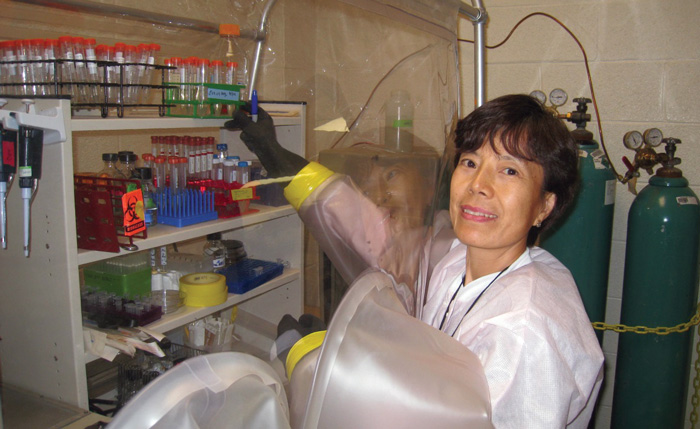Innovations in Vegetable Fermentations
FOOD SAFETY AND QUALITY
Vegetable fermentation and packaging for these products are experiencing innovations. Developments include fermentation acceleration, new starter culture uses, swapping calcium for sodium in brines, and use of bacteriophages.
Accelerated Fermentations
Following the trend for lower salt in fermentations, processors are looking at calcium chloride (CaCl2) as an alternative to salt or sodium chloride (NaCl). Using commercially available bacterial starter cultures and substituting CaCl2 for NaCl, fermentations can proceed with rapid pH reduction to values below 2.9 (Scott 2017). The accelerated fermentation requires exposing a portion of the internal flesh of the fresh produce, which can be accomplished through piercing, cutting, slicing, or dicing. Besides the addition of a bacterial starter culture, the fermentation needs 0.5%–2.0% CaCl2 (w/w basis), and at least either a yeast or mold inhibitor, an herb, and a spice. The produce can be fermented in the brine solution at temperatures ranging from 25°C–35°C for ≤ five days. The fermentation is complete when the sugar concentration of the brine is < 0.1%. The starter cultures are used because they produce acid more rapidly than the native bacterial flora found on the skins of the vegetables. The target pH for commercial pickle fermentations is 2.9–3.9. This method has the potential to reduce the large amount of labor and capital needed to maintain extensive outdoor tank yards as the vegetables can be processed more rapidly.
Accelerated fermentations have been proven to be stable. Cucumber pickles fermented by this method did not experience any quality degradation for up to two years in outdoor tanks, according to Lisa Moeller, owner and principal consultant of Fashionably Pickled LLC. The use of CaCl2 also reduces the need to dispose of large amounts of sodium-rich brines and increases the firmness of the product.
New Trends
Moeller, who has been involved in the pickle industry for more than 32 years, specializes in development of new fermented products, environmental sustainability, procurement, and processing. Her interest began as a child helping her grandmother make pickled green tomatoes and watermelon rinds.
“One of the exciting areas coming up is the use of specific bacterial cultures for new flavors. Buttery, cheesy, and alcohol-sweet are flavors which are desirable and attainable using the right combination of temperature and raw ingredients,” says Moeller. “Radishes, cabbage krauts, cucumbers, and chickpeas can produce some exciting finished flavor profiles with optimization of final formulations needed to give exceptional results.”
Moeller’s experience has given her a good perspective on some of the ways in which trends in fermented and acidified vegetables vary around the world. “In the United States, we have a higher standard of living and lots of choices concerning foods,” Moeller continues. “Internation-ally, energy has a substantial cost, so frozen foods are not as popular as they are here. Alcohol-sweet is desirable in countries where drinking alcohol is discouraged but the flavor is desirous in foods. In Turkey, it is taboo to consume alcoholic beverages. However, I’ve observed that consumers like a low level of alcohol content in their olives. This improved flavor is imparted by a 1 in mat of yeast and mold on the top of the olive fermentation vessel.”
Fermenting foods can add value by increasing the nutritional value and decreasing the energy needed for storage. Moeller points out that shelf-stable items have assumed increased importance for many consumers as a result of the ongoing COVID-19 pandemic.
“Much of the produce that used to be consumed fresh can now be fermented and stored until needed,” she notes. “Fortunately, jalapenos, carrots, and cauliflower can all be fermented well. This year, in addition to farmers, workers that pick, haul, and prepare food have been affected by the COVID-19 pandemic. Disruptions in worker availability, transportation, and the shift from processing and packaging for foodservice to retail has touched the entire food industry. Planted fields are now smaller and crops are rotated due to lack of available hands to plant and pick.”
Fermenting vegetable products can also yield sustainability benefits, Moeller observes, citing opportunities to help reduce agricultural impacts on climate change. “One example of waste reduction is use of nubby, misshapen carrots, not as culls but ground up into slaws,” says Moeller. “Also, the fermentation of food byproducts and culls can create value-added products for livestock and consumers or be used as alternative energy sources.
“Reduced-sodium items and reducing salt waste continue to be popular,” she says. “Many years ago, one of the favored items for pickles was the Genuine Dill. These cucumbers are fermented and stored in the same brine, thus reducing waste at the processing plant. The brine is generally cloudy, and the main acid is lactic acid. In the United States, 100% of vegetable fermentations using salt brine are rinsed and repackaged with vinegar solutions. Dumping of the brine is an environmental issue that processors must face.”
Future of Pickled Vegetables
Members of the Hausbeck family have been fermenting and acidifying vegetables at Hausbeck Pickle Co. in Saginaw, Mich., since 1923. The state is pickle country, having optimal temperatures and plenty of available water to irrigate the crops. The Hausbecks have stayed in business because they continue to innovate and find new markets for their pickle products.
One major innovation is packaging. They use vacuum form-and-fill pouches constructed with 10 mm film. These packages are smaller and lighter, allowing them to save on shipping costs compared with glass. The pouches also allow packing of more solid product than liquid brine.
The Hausbecks have also updated and automated their processing plant, allowing them to hire trained workers at a living wage. The majority of their clients are quick-service restaurants that need peppers and other savory additions for their offerings. They pride themselves on customizing products to fit their clients’ needs. COVID-19 challenged them this year, causing a closure for the entire month of April. To reopen, the Hausbecks have followed all government guidelines and recommendations. This includes social distancing on the production line, erecting plastic shields to separate workers, wiping down touch surfaces, the donning of masks, and daily surveys to screen incoming employees.
Joe Hausbeck, the grandson of the founders of Hausbeck Pickle Co., underscores the importance of adapting to the new processing and market realities. “Businesses which survive will be those who decide to adapt. They must address both the COVID-19 pandemic and climate change,” he emphasizes. “Consumers want more nutritious, longer shelf-life foods, and variety in their fermented foods. Some pushback and consumer education will be needed as clean labels will change formulations, and the shelf life is not as long.
“Fermented foods are inherently safe due to low pH, lactic acid, biocidal compounds, and bacterial inhibition of pathogens,” Hausbeck continues. “The biggest challenges coming up will be creating more environmentally friendly, decomposable, and cost-effective packaging; energy efficiency using new sources such as solar and wind; dealing with labor shortages and outages caused by the pandemic; dealing with clean label demands; and creating new products for the evolving consumer.”
Using Phages in Vegetable Fermentations
The U.S. Department of Agriculture’s (USDA) Agricultural Research Service Food Safety Lab has been a leader in vegetable fermentation research since the 1940s. In an article published earlier this year, it was reported that cucumber fermentations contain an abundance of phages, which infect Gram-negative bacteria (Lu et al. 2020). Jean Lu, at Kennesaw State University, and her USDA collaborators found eight distinct phages with unique Gram-negative hosts. Phages belonging to the Myoviridae, Siphoviridae, and the Podoviridae families were isolated and characterized. Gram-negatives are undesirable because they cause bloater defects and softening of the cucumbers during fermentation.
The addition of salt brines to vegetables favors the growth of lactic acid bacteria and enables them to outcompete with Gram-negative bacteria such as Enterobacter species. This research alters the opinion that only chemical and physical factors such as acids, salt concentration, oxygen depletion, low pH, and bacteriocins cause inhibition of undesirable Gram-negative bacteria. The research further builds on the past discovery of phages present in sauerkraut fermentations, allowing the fermentation to transition from heterolactic to homolactic (Lu et al. 2003).
Since 2006, both the Food and Drug Administration and the USDA have approved several phage products for use in foods. These determinations include additive approval and GRAS recognition, and mention of use as clean label aids (Wikipedia 2020). Future work by Lu and collaborators will explore the use of phages as natural inhibitors of undesirable native flora on cucumbers and better understanding of the role of phages in vegetable fermentations.
REFERENCES
Lu, Z., F. Breidt, V. Plengvidhya, et al. 2003. “Bacteriophage Ecology in Commercial Sauerkraut Fermentations.” Appl. Environ. Microbiol. 69: 3192-3202. doi:10.1128/aem.69.6.3.3192-3202.2003.
Lu, Z., I. M. Perez-Diaz, J. S. Hayes, et al. 2020. “Bacteriophages infecting Gram-Negative Bacteria in a Commercial Cucumber Fermentation.” Front. Microbiol. 11: 1306. doi:10.3389/fmicb.2020.01306.
Scott, W. A. 2017. Quick pickle fermentation cure. U.S. Patent 9,585,415,415 B2.
Wikipedia. 2020. Bacteriophage. https://en.wikipedia.org/wiki/Bacteriophage.




